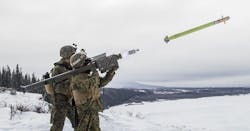Army asks Raytheon to build infrared-guided Stinger anti-aircraft missile in $624.6 million order
REDSTONE ARSENAL, Ala. – U.S. Army air-defense experts are asking Raytheon Technologies Corp. to build additional FIM-92 Stinger shoulder-fired anti-aircraft missiles under terms of a $624.6 million order announced Friday.
Officials of the Army Contracting Command at Redstone Arsenal, Ala., are asking the Raytheon Missiles & Defense segment in Tucson, Ariz., to build Stinger missiles and related equipment.
One soldier can operate the FIM-92 Stinger -- a portable air-defense system that operates as an infrared homing surface-to-air missile that can be fired from a wide variety of infantry launchers, military ground vehicles, and helicopters.
The passive surface-to-air missile can be shoulder-fired by one operator, and can acquire the target when the target approaches the operator, giving much more time to acquire and destroy the target. The FIM-92B missile also can fire from the M1097 Avenger and the M6 Linebacker weapon systems.
The missile also can deploy from a Humvee Stinger rack, and can be used by airborne troops. A helicopter launched version exists called Air-to-Air Stinger (ATAS).
The missile is five feet long, 2.8 inches in diameter, and weighs 22 pounds. It has a targeting range of about three miles and can engage low-altitude enemy threats from as far away as 2.3 miles. The missile travels as fast as Mach 2.5, and has a 2.25-pound explosive warhead.
It entered service in 1981 and is used by the militaries of the U.S. and 29 other countries. Airbus Defence in Germany and by ROKETSAN in Turkey also can build the missile under license from Raytheon.
There are three main variants: the Stinger Basic, Stinger-Passive Optical Seeker Technique (POST), and Stinger-Reprogrammable Microprocessor (RMP).
The POST and RMP variants have a dual-detector infrared and ultraviolet seeker that enables the missile to distinguish targets from countermeasures. The Stinger-RMP can load a new set of software via read-only memory.
The weapon has more than 270 fixed-wing aircraft and helicopter intercepts to its credit. Stinger missiles also can destroy unmanned aircraft with proximity fuzes.For more information contact Raytheon Missiles & Defense online at www.raytheonmissilesanddefense.com, or the Army Contracting Command-Redstone at www.army.mil/acc.
About the Author
John Keller
Editor-in-Chief
John Keller is the Editor-in-Chief, Military & Aerospace Electronics Magazine--provides extensive coverage and analysis of enabling electronics and optoelectronic technologies in military, space and commercial aviation applications. John has been a member of the Military & Aerospace Electronics staff since 1989 and chief editor since 1995.
